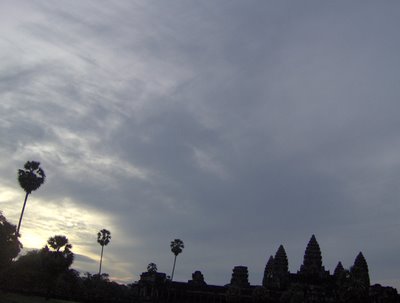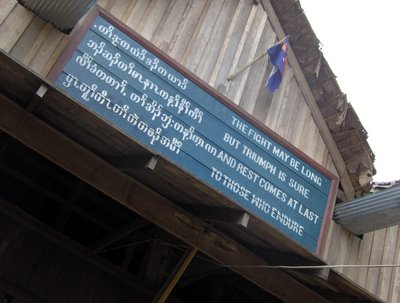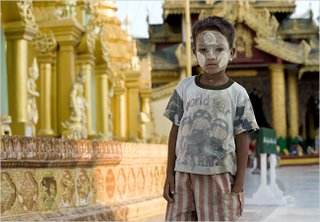
Therefore I didn't take many pictures. I did have to write an essay afterwards, though, which may in fact stand in for more analysis here. Should I post it? It would be my usual self-aggrandizement taken to a whole new level. I do like whole new levels, though. Okay I'll do it. Fine! You'll notice it's a little heavy-handed in places, a little too afraid to let my "experiential learning" speak for itself without the helping hands of secondary sources. Alas. Our Academic Director didn't notice, though.
The smiling guy at the top is Ganbat, my host-father while I was in Dadal. Dadal is a soum in Hentii aimag, a province in the northeast of Mongolia. Our homestay sites were about 25km from Siberia, but it wasn't unbearably cold. I took the picture at the top of the mountain that sort of towered over the cabin we - Ganbat, Uranchimeg, and I - were living in. At the top, there is an "oboo," which is a place where Mongolians making offerings to "gazariin ezen," land spirits that watch over the natural environment. We scattered some offerings, and we placed more stones on the oboo. You've probably seen pictures - the piles of stones generally arranged in a small pyramid.
Enjoy the reading. Please don't hate me. Also please don't make fun of me. We are a fragile people, we...people.
"Finding and Losing New York in Dadal"
Anthropologists seem to believe that inspiration emanates from strange sources. In a way, one could argue the entire field is oriented around this possibly banal maxim, this belief that significant meaning may lie not in the obvious places⎯the libraries of the world, for example, or newspaper and television sources⎯but in marginal, or marginalized, spaces. How else could Claude Levi-Strauss, the field’s pre-eminent cultural anthropologist, get away with ending his masterwork Tristes Tropiques with his notoriously feline conclusion? “The essence of what (our society) was and continues to be,” he argues, deeply submerged in his famously urgent, lyrical style, may best be located in the consideration of a mineral, the perfume of a flower, “or in the brief glance, heavy with patience, serenity and mutual forgiveness, that, through some involuntary understanding, one can sometimes exchange with a cat” (415). So ends what many believe to be the central work of modern anthropology⎯and so ended, as well, my two weeks of living in Dadal, in the cabin of a talkative Buryad named Ganbat.
Indeed, the only difference between Levi-Strauss’ challenging conclusion and what I would consider the critical experience of my time in Dadal is the animal in question. For me, it was interaction with a lamb that opened up for me a sense of social essence, though whether my newfound grasp was upon this Buryad community or my own New York City is difficult to say. On my last evening living with Ganbat, I joined him outside, as I had done on most nights, for the closure of the day’s outdoor chores: picking up manure, milking the cows, distributing the hay for the animals, watering the horses, and herding the animals to their specified places. As we rode away from the cabin, herding some of the cattle towards a feeding location about a kilometer from Ganbat’s fenced-in space with the cabin, the sun was hung low on the horizon, already a fuchsia ghost of its midday self. The sky was all sherbet hues, the breeze crisp and cold on my face as we trotted the horses behind the cattle. Certainly a place rich in sunsets, I thought to myself as we eventually turned back towards the cabin.
As Ganbat gathered my saddle to bring it indoors, his wife, Uranchimeg, who had been milking cows, pointed to the lamb we had been keeping inside the cabin⎯its mother had been refusing to nurse, so Uranchimeg had taken to feeding it from a bottle. I picked it up⎯it, like all of our family’s animals except for one dog, lacked any particular name⎯as my host-mother and father headed inside. For a moment, a moment that for all I know could have lasted quite a long time, I held the lamb as I kneeled on the grassy dirt of Ganbat’s yard. My grainy leather gloves acted the coarse movement of my hands over the lamb’s curly white coat. Even through my quite weathered gloves, softened by ski lifts and hardened by duct tape, I could feel the warmth of the lamb’s barely rounded underside, the knobby spine of its only lightly padded back. Slowly I moved my left hand to the lamb’s face, gently turning it towards my own as I squinted into the sunset rays coming low and piercing over the ridge in the distance. Unlike Levi-Strauss’ visual communion with his cat, though, the glance I shared with the lamb was brief, its eyes quickly averted like those of a nervous child. I stood up, hoisting the lamb in my arms as we faced the last glow of sunset. The lamb, poor and small in its cradle against my chest, was quiet as I made my⎯our⎯way inside Ganbat’s cabin.
As had happened several times already over the course of my stay with Ganbat, the evening light sent rushing a flood of reflection, a chorus of arias singing the wandering thoughts of days spent in immersion. Again, Levi-Strauss is here before me. “And so,” he writes, “it is when…(the sun’s) disc outlines mountain summits like a hard, jagged leaf, that man is eminently able to receive, in a short-lived daydream, the revelation of the opaque forces, the mists and flashing lights that throughout the day he has dimly felt to be at war within himself” (63). The war within me, the mild conflict that surfaced in the lamb’s dark, swirling eyes, had something to do with distance⎯the literal and spatial distance between Dadal and my now-native Manhattan, and the more symbolic, narrative distance between the two apparent extremes, one rural and one urban. One particular image asserted itself against the eyes of the lamb: that of the Statue of Liberty, that great marvel of mossy green that keeps watch, torch aloft, over New York’s harbor.
It is just such an image, in fact⎯and it is very much an image⎯that graces the back cover of a book I gave to Ganbat’s family, a collection of tourist-oriented photographs telling a visual story of New York City. I’d purchased it in Times Square, and now it rested on the cabinet of a Mongolian herder. The focal point of the photo of “Lady Liberty” seems to be her eyes, which like the rest of the statue are set in what appears to be a severe granite, unfeeling and cold to the touch, the huge sculpture cast in a way that harmonizes with its eyes, to which the French sculptor neglected to apply any detail: majesty without empathy, grandeur without feeling. Like the Balinese cockfight for Geertz, the photobook I gave Ganbat depicts a story people tell themselves about themselves: this picture of American liberty, however, is only surface-deep (448). Unlike the lamb, alive, warm, and responsive to my touch, the Statue of Liberty exists behind an antiseptic, even impenetrable, veil of myth. This treasure of American mythopoeic consciousness lives not in our hands but on glossy pages, framed by photographers and guarded by price tags.
So it is that I found the central truth of my time with Ganbat less in structured instances of data collection, valuable as those moments were, and more in the strange comparison of two sets of eyes⎯the one animal, the other carved. New York City, concrete jungle that it is, began to seem, for me, a landscape no less strange than that of the Mongolian steppe, a place with stories⎯told by us, about ourselves⎯no less fantastic than the Buryad creation myth. Therein lies, perhaps, one of the great values of interaction across boundaries: the ability to regard both sides as unfamiliar. How else to achieve the critical insight necessary for an ethical life? In a passage often cited by the literary scholar Erich Auerbach, the twelfth-century Saxon monk St. Victor of Hugo extols this sense of deterritorialization. “The man who finds his homeland sweet is still a tender beginner,” the monk writes. “He to whom every soil is as his native one is already strong; but he is perfect to whom the entire world is as a foreign land” (Said 185). This preparedness to regard all things as foreign is a huge part of what I now carry with me from my stay in Dadal.
That the seed of this epiphany lies in Levi-Strauss is no unhappy coincidence, his work having deeply informed my own understanding of the anthropological project. Nevertheless, the role of literature in conducting fieldwork, anthropological though that literature may be, would appear to be a minor one, one that logic suggests I should consign to a lesser role upon my own increasing comfort with field research. If, as Levi-Strauss suggests, social science properly takes place in the hinterland of experience⎯with the diamond, the flower, and the cat marking his beautifully weird landscape⎯then the refuge of the printed word becomes instructive more at some later point. For now, though, it seems crucial to acknowledge the extent to which Tristes Tropiques, as truly affective works are wont to do, plays the lens in analysis. Recollection, after all, necessarily requires mediation: the present leaves no moment past untainted by a sentimental film. On that last night of my stay with Ganbat, then, as the stream of reflection flowed towards me beneath the softening fluorescence of sunset, I did nothing to refuse the wave of memory⎯the memory that suggested, in fact, that I had found, and lost, New York in Dadal⎯and the conflicting images it stirred up. I gave way, I gave in, and I surrendered, unwittingly proving yet another of Levi-Strauss’ truths: “Remembering is one of man’s great pleasures…Memory is life itself, but of a different quality” (63).
(Works Cited)
Geertz, Clifford. The Interpretation of Cultures. Basic Books: New York, 2000.
Levi-Strauss, Claude. Tristes Tropiques. Penguin Books: New York, 1992.
Said, Edward. Reflections on Exile. Harvard University Press: United States of America, 2000.












